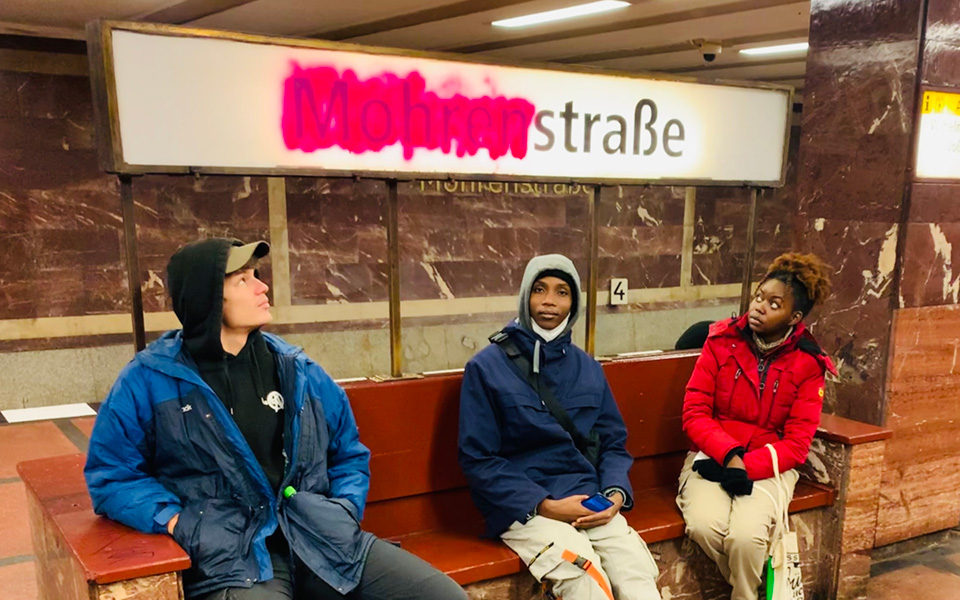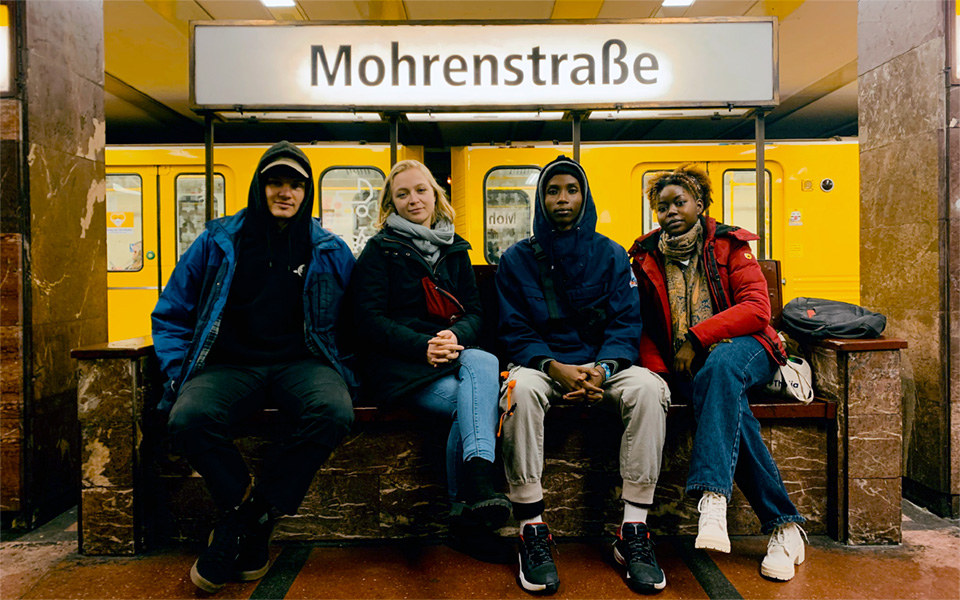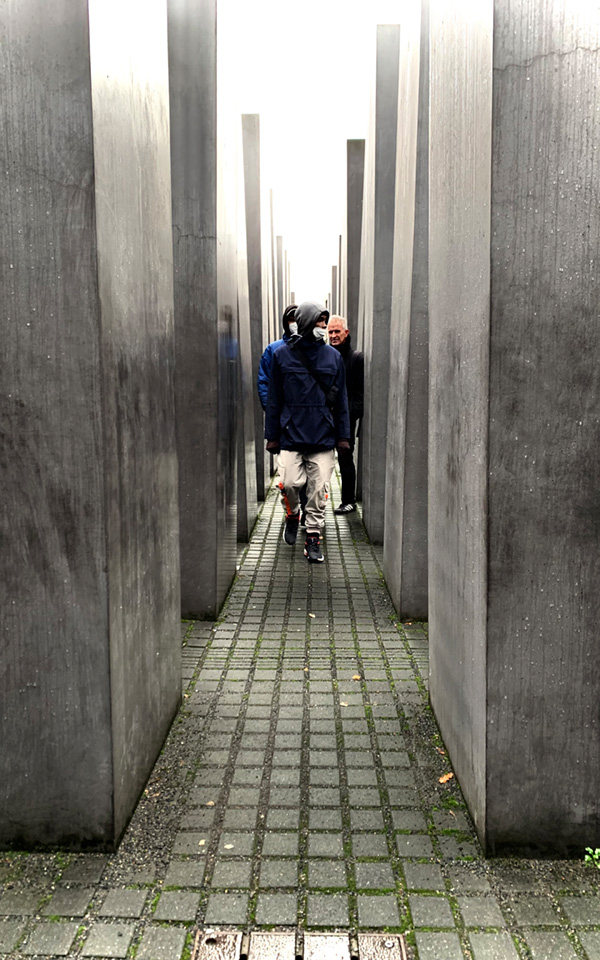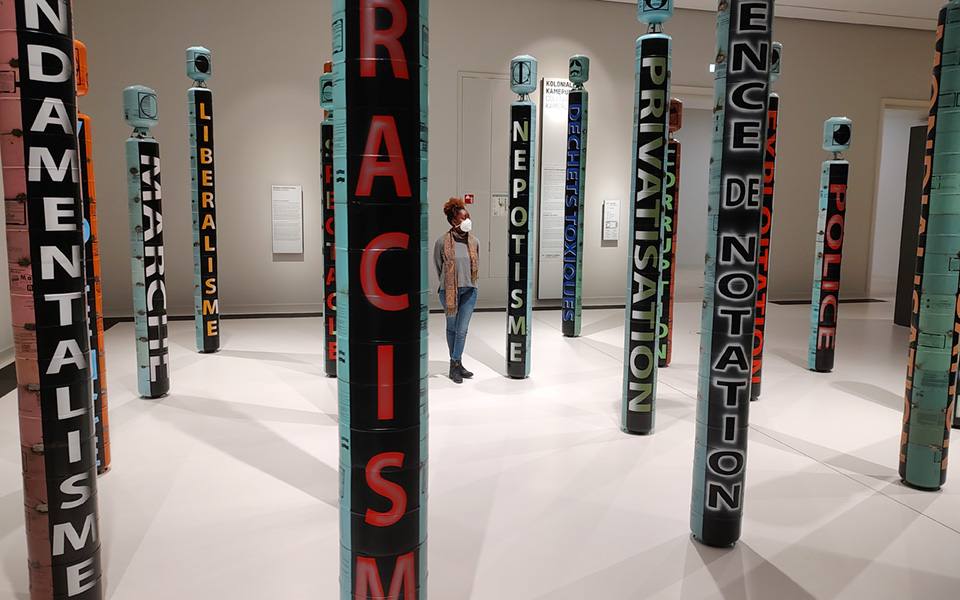Projects | Berlin (2021/22)
BIKO
– Tackling German Colonialism
In March 2021, Memos began working on a concept linking formal and non-formal education on colonialism and responsibility in Berlin Schools. The undertaking has been inspired by a funding programme launched by Berlin’s Senate Department for Education, Youth and Family and is implemented by the Foundation Nord-Süd-Brücken. The programme’s German title is BIKO: Bildungsarbeit zu Kolonialismus und Verantwortung in Berliner Schulen. The proposed activity plan is based on the Berlin framework curricula for teaching at upper secondary level and is rooted in the learning outcomes of previous Memos-projects.
Memos has assembled a BIKO-team comprised of four young people: King Kivumbi and Pio Kwizera from Kigali, and Amelie Brix and Valery Scheuerpflug from Berlin. In recent years, all four have been involved in international youth encounters and cultural projects organised by Memos. In 2020, King and Valery have created the video essay "More About Richard Kandt", which plays a vital role within BIKO.
In September 2021, Memos and BIKO have received an unexpected boost of inspiration when Berlin’s new Humboldt Forum opened the first section of the museum’s Africa Exhibition. First and foremost, Humboldt Forum is committed to reappraise the collections from colonial times and the violent methods by which they were acquired. On top of that, the Africa Exhibition tackles our patterns of perception, by dissecting the underlying ways of seeing that contributed to Colonialism and were in turn shaped by it. We as visitors are invited to trace back in which way our frames of reference and worldviews are influenced by the sociocultural environment to which we belong.
Secondary schools from Berlin are invited to participate in online workshops aiming to
- stimulate an active debate on Germany’s historical responsibility;
- reappraise colonial injustice;
- sensitize for colonial continuities in society;
- trigger processes of decolonisation.
BIKO-project "Richard Kandt – Africa Explorer, Colonial Official, Name Patron"
Concept for a
project day with secondary school students and teachers in Berlin
(for both in-person and online use)
We approach Richard Kandt’s life and work, in particular his time as
Germany’s Representative in Rwanda (1907 – 1914) in three ways:
MODULE I
Methodology: City walk to original sites in Berlin’s Mitte district
(Allow 10 minutes for the walk from Wilhelmstraße 92 to U-Bahn Mohrenstraße and 40 minutes for the walk from Mohrenstraße via Gendarmenmarkt to the Humboldt Forum including the check-in at the Africa Exhibition.)
(1) Memorial plaque in Berlin: Berlin Africa Conference, Wilhelmstraße 92,
https://www.gedenktafeln-in-berlin.de/gedenktafeln/detail/berliner-afrika-konferenz/2839
(15 minutes)
(2) Dekoloniale, Wilhelmstraße 92 (!),
Dekoloniale Memory Culture was inaugurated in January 2020 as cultural
project to critically deal with the history of colonialism and its
consequences.
https://www.dekoloniale.de/en/manifest/representations
(15 minutes)
(3) Subway station
U-Mohrenstraße, https://www.berlin.de/kunst-und-kultur-mitte/geschichte/erinnerungskultur/strassenbenennungen/artikel.1066742.php
(40 minutes)
MODULE II
Methodology: World Café in the Humboldt Forum’s Africa Exhibition
Inspired by the Humboldt Forum's Africa exhibition, the Memos-team has created three video essays tackling the case of German colonialism. They are entitled "Archive of the World Civilisations", "White Frame of Reference" and "Tracing History for Young Visitors”. The video essays are instrumental for the implementation of the BIKO project days.
(Participants divide into 3 facilitated learning groups that take turns to explore the Africa Exhibition’s main themes. For online project days, Memos makes three subject related 4-minute video clips available. Please contact info@memos.ngo for further information.)
(1) Archive of the World Civilisations (40 minutes)
In the summer of 2021 the Humboldt Forum opened up in the historic center of Berlin. It is a venue for art and culture, science and education. Originally, this site was home to the Berlin Palace and once an important baroque building. It was damaged in World War II and demolished in 1950. From 1976 until 1989, the site was occupied by East Germany’s "Palast der Republik", a cultural center as well as the home of the government of the German Democratic Republic.
The building takes its name from the Humboldt brothers, Alexander and Wilhelm, both of whom were renowned scholars in the 18th and 19th century. Their visions are today the inspiration for the cultural and scientific programmes of the Humboldt Forum. The Africa collection was established in the 17th century and has its origins in the Brandenburg-Prussian cabinet of wonders.
In 1886, Germany’s first ethnological museum was founded in Berlin. Two years before, the European States, the USA and the Ottoman Empire had signed the Congo Act at the Berlin Conference, which had far reaching consequences for the colonization of Africa. Today, Museums are increasingly focussing on the critical reappraisal of holdings from colonial times and the violent methods by which they were acquired.
The Cameroonian artist Justine Gaga presents an installation of 19
sculptures made of painted gas canisters. Her piece of art is entitled "Indignation"
and addresses the legacies of colonial rule: She first conceived it for the
Center of Contemporary art located at the Palace of Rudolf Douala Manga Bell,
who was executed by the German administration in 1914. Based on the
installation students discuss the connection between art and protest. How do we
express our indignation? What outrages us? They examine objects from colonial
contexts and the continuity of colonial injustice until today. Along with
Cameroon five other African countries have been directly affected by German
colonial rule: Togo, Namibia, Tanzania, Burundi and Rwanda. There, Richard
Kandt – the protagonist of our BIKO-project – has resided.
(2) "White Frame of Reference" (40 minutes)
"Why is it so hard for white people to talk about racism?" In 2018, author Robin DiAngelo addressed this provocative question to the American public. In her bestselling book "White Fragility" she tackles the defensive instincts or reactions that a white person experiences when questioned about race. DiAngelo views racism rather as a systemic mechanism perpetuated unconsciously by individuals than as a phenomenon committed intentionally by "bad people". She points out that our view of the world is influenced by our cultural environment and the specific groups to which we belong. In order to overcome present-day and historical contexts of injustice, it is essential that we become aware of the lens through which we view others.
The former German colonies were inhabited by German military personnel, teachers, businesspeople and their families, scientists, people searching for meaning, artists and many others. Photographs from various decades provide an impression of their lives and the lives of their descendants. The images convey the convictions and goals that guided them as well as how they saw their surroundings.
In recent years, ethnological collections held by European museums have come under critical scrutiny. The Humboldt Forum seeks to meet this challenge head on. "Matter(s) of perspective: An Overture" examines the underlying ways of seeing that contributed to colonialism and were in turn shaped by it – many of them still very much in place today. This allows us to understand colonialism as a phenomenon that touches on all aspects of society.
The installation focusses in particular on the traces of colonisation in the former German colonial territories. Photos, school textbooks, sculptures are the starting point for this examination of how the colonizers and the formerly colonised societies saw one another. Characteristic of these ways of seeing is the differentiation between "us" and "the others".
To shift the focus back to the act of seeing itself and in the interest
of the current discussion on the repatriation of objects – the exhibition
focusses not on things or tangible objects from the collection, but on
reproductions. Moreover, artistic works enable viewers to become aware of both
cultural and institutional ways of seeing.
(3) "Tracing History for Young Visitors" (40 minutes)
An innovative feature at the Humboldt Forum’s Africa Collection is "Family Space Cameroon". Under the guiding question "What does history mean to me?" an interactive slide show responds to the questions of young visitors.
Why would a child from Cameroon join the German colonial troops? Colonial troops earned a lot of money compared to other jobs. Some children who joined the troops were orphans or had no other choice. Others were from military families and followed in their fathers’ footsteps. A musically gifted child could play in a military band.
Why does one soldier not have shoes? Shoes were expensive and a privilege. The sergeant to the left has shoes, the regular soldier doesn’t.
Who are these men? We don’t know. The Germans took many photos of locals, but were not interested in their identity. We only know that these men are wearing the uniforms of the colonial troops.
What is propaganda? Propaganda is when the information is twisted to make you believe something that is not true. Here we see a propaganda postcard that makes it look good to be part of the colonial troops. But sometimes you had to fight against your own people.
What type of work did a soldier do? Soldiers had long days of military drills, fitness training, marching, to take care of and use their weapons.
Why are these men standing at attention? We don’t really know. The photographer did not give us enough information. This photo creates more questions than it answers.
Are there any more colonial troops today in Cameroon? Today Cameroon is an independent country and controls its own army. Both men and women serve there.
Why does the inside of this palace look familiar? King Rudolf Manga Bell decorated his palace in a European style, because he had lived in Germany for many years and spoke German fluently. Unfortunately, the Germans were mostly interested in exploiting Cameroon for their profits, not in creating good living conditions for their people. When King Rudolf Douala Manga Bell spoke out openly against the Germans, they had him executed in 1914. Today he is considered a hero in Cameroon and is called the father of the nation.
The photo of Rudolf Manga Bell’s family was taken just before many of
them left for a trip to Germany to make their case for human rights before the
Emperor, Kaiser Wilhelm II. The photo of the funeral of Rudolf Manga Bell’s
father was taken in 1908. After his execution in 1914, Rudolf Manga Bell
himself did not receive a proper funeral. Only 21 years after his death he was
buried in dignity.
MODULE III
Methodology: Fish Bowl Discussion based on the video "More About Richard Kandt"
(In a Fishbowl discussion, 4 students seated inside the "fishbowl" actively participate in a discussion by asking questions and sharing their opinions, while students positioned outside listen carefully to the ideas presented. Students take turns in these roles, so that they practice being both contributors and listeners in a group discussion.)
(1) Sharing and understanding the subtitled 10-minute-video "More About Richardt Kandt" created by King Kivumbi and Valery Scheuerpflug and available on the Memos website. (30 minutes)
(2) Fishbowl discussion on the question if the "Kandt House Museum in Kigali" should change its name. Also the participants will explore how best German school students could share their views with the National Museum of Rwanda and other relevant authorities. (60 minutes)
(3) Group assessment of the project day (30 minutes)
Additional information
Here you find in-depth information about colonial street names and their renaming in Berlin’s Mitte district, in particular on the history of Mohrenstraße
and the renaming debate (only in German): https://www.berlin.de/kunst-und-kultur-mitte/geschichte/erinnerungskultur/strassenbenennungen/artikel.1066742.php







